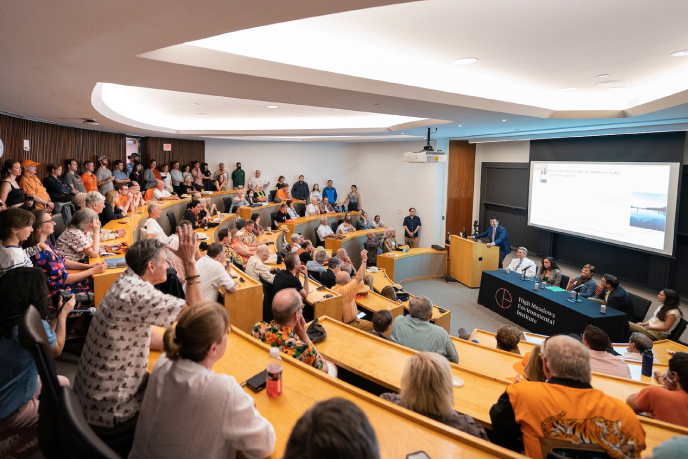Green Skies: Engineer’s Work May Reduce Jet Travel’s Role in Global Warming
Princeton Professor of Mechanical and Aerospace Engineering Fred Dryer has a lofty goal: end the nation’s reliance on oil for jet travel.
With potentially major benefits for energy security and the environment riding upon his success, Dryer is advancing the fundamental knowledge of jet fuels while developing practical, innovative energy sources.
“In order to make alternative jet fuel sources feasible, they need to be compatible with petroleum and produce similar combustion performance,” Dryer said. “This will only be possible if we fully understand how both petroleum and alternative fuels burn and design engines based on this fundamental knowledge.”
Backed by government and industry grants, Dryer is leading two new research efforts to advance these technologies. The first, a major project funded by the U.S. Air Force, is focused on developing computational and kinetic models that accurately simulate the burning of jet fuel, a complex and poorly characterized mix of chemicals. At the same time, he is putting his basic understanding to use as he develops jet fuels with near-zero net greenhouse gas emissions in a project funded by NetJets, a leading provider of business jets.
The Air Force program is one of the Defense Department’s highly competitive Multi-disciplinary University Research Initiative (MURI) grants. One of only ten such projects supported by the Air Force this year, the collaboration involves researchers from four institutions — Princeton, Case Western Reserve University, Pennsylvania State University and the University of Illinois-Chicago. The award, with an overall value of up to $7.5 million, will provide support for three years with the option of a two-year extension. Research began in July and the kick-off meeting for the project will be held Sept. 17 in Princeton.
Dryer and his MURI collaborators, including Princeton Associate Professor of Mechanical and Aerospace Engineering Yiguang Ju, will develop methods to predict and evaluate how jet fuels will behave in actual engines and characterize the emissions they will produce. While current guidelines specify some overall properties of jet fuels, they do not spell out the actual chemical composition. Depending on the source and processing method, jet fuel typically consists of hundreds to thousands of molecular structures that behave in a variety of ways.
The models developed by the team will represent and characterize the behavior of this broad range of jet fuel species using only a few types of molecular structures as surrogates for the larger whole. Dryer previously developed similar “surrogate fuel” models to represent gasoline, which are now being used for engine design by the automotive industry.
“The composition of fuels changes with the geographic source, the refining process and even with the season,” Dryer noted. “Since we have an energy security problem, we need to be sure that alternative fuel sources are going to work and, in order to do that, we need to understand exactly how petroleum-based fuels work alone and in combination with alternative fuels.”
Alternative energy sources, if designed appropriately, also could significantly reduce the amount of greenhouse gasses released in creating and burning jet fuel. According to the U.S. Department of Transportation, aviation is responsible for around 10 percent of the greenhouse gas emissions from transportation in the nation, or roughly 2.7 percent of the country’s total greenhouse gas emissions. The second research program, supported by NetJets, augments Dryer’s fundamental MURI work and brings in additional expertise from the Princeton Environmental Institute to develop “greener” alternative fuels.
“NetJets is pleased to be working with the engineers and scientists at Princeton to develop new jet fuels with near-zero net greenhouse gas emissions,” said NetJets Chairman and CEO Richard Santulli. “Princeton has a longstanding history of leadership in aerospace science. We feel they will make great strides with this research.”
The NetJets-funded research project provides the opportunity to make substantial progress toward the launching of green technologies not only for corporate jets, but also for commercial aviation and transportation in general, according to Robert Williams, a senior research scientist at the Princeton Environmental Institute and member of the NetJets-sponsored research team. At Princeton, the team also includes Ju and Eric Larson, a research engineer at the Princeton Environmental Institute. In addition, the work will involve collaboration with researchers at the Institute of Transportation Studies at the University of California-Davis.
Two alternative fuel sources that are the subject of much investigation in the aviation field — coal and biomass — present a major quandary to researchers attempting to develop low-emissions jet fuels. Coal, a relatively cheap and readily available source of energy, has an emissions profile at least as harmful as petroleum. Biofuel — fuel made from plants — presents an attractive alternative because the carbon dioxide emitted from burning biomaterials will be removed from the atmosphere by a new generation of plants during photosynthesis. The production of biomaterials, however, requires the intensive use of land, limiting the feasibility of widespread production of biofuels.
To take advantage of the positive characteristics of each of these sources, the Princeton researchers will center their efforts on the synthesis of jet fuels from a combination of coal and biomass. A key component of their solution is isolating and storing the carbon dioxide produced during the production of so-called synfuels. This technique, called carbon capture and sequestration, is a promising strategy being investigated intensively by Princeton’s Carbon Mitigation Initiative, among other research programs.
An “especially attractive feature” of processing coal and biomass together to make synfuels is that it requires only half the amount of biomaterial as pure biofuel production, while still making fuels with near-zero greenhouse gas emissions, Williams said.
The ultimate success of the research efforts will depend on how well the synfuels compare with traditional fuel sources, in terms of fuel characteristics, costs and environmental and safety issues, the researchers said.
“There is no doubt that developing feasible alternatives to petroleum for the aviation industry will be a long and expensive process,” Dryer said. “And success, in the form of an enduring solution, will be priceless.”



